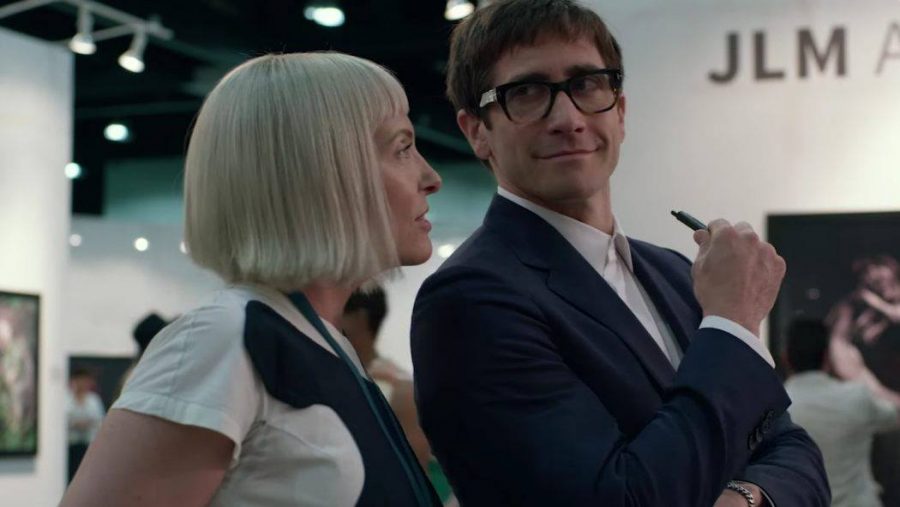Dan Gilroy’s “Velvet Buzzsaw” provides a gory, fantastical look into the contemporary art world that shoots for the stars but, unfortunately, still doesn’t make it to the moon. Although the horror film attempts to expose the absurdity of the art world, at times it is guilty of becoming as self-serving as the people and establishments it satirizes. Still the film delivers an imaginative, darkly delightful portrait of the soulless exchange of art — objects defined primarily by their monetary potential.
Jake Gyllenhaal gives a captivating performance as prominent art critic Morf Vanderwalt, a spectacled compulsive character who stands at the center of the film. When his colleague and lover Josephina (Zawe Ashton), assistant to cutthroat gallery owner Rhodora Haze (Rene Russo), finds the dead body of the reclusive Vetril Dease in her apartment complex, and subsequently discovers a stock of what Morf describes as visionary paintings in the dead man’s apartment, the consequences of each character’s actions become increasingly deadly and inevitable. Soon, what began as a somewhat lighthearted satire transforms into a gory slasher film.
The film suffers from subpar dialogue. Much of it comes off as trite and even laughable, such as when up-and-comer artist Damrish (Daveed Diggs) asks Rhodora why her punk band — the titular Velvet Buzzsaw — fell apart, and she replies “Who can remember through all the drugs and booze?” Or, when a frantic Gyllenhaal proclaims, “Something truly goddamn strange is going on!” and we have trouble deciphering whether or not this is done in earnest or in sardonic adherence to the tropes of the horror genre.
Characters like art adviser Gretchen (Toni Collette) and Rhodora are presented as deeply persuasive and quick-witted, and yet their dialogue is not quite as acerbic as one wants it to be.
Gilroy does, however, give us a few brilliant visual experiences. One of note is the mesmerizing yet petrifying scene in which Josephine stands unwittingly in a pool of melting paintings, to ultimately be smothered and cemented into a wall of graffiti. Watching Collette’s face descend into panic as her arm is sawed off by an interactive exhibit is equally transfixing for its pure gore, as the sterile, insulated gallery becomes a bloody crime scene.
Scenes like the one in which Gretchen’s dead body is mistaken as an inanimate element of the “Sphere,” an interactive metal globe that sells for $7 million, are meant to disturb and revolt through their stark presentation of the ludicrousness into which contemporary art has arguably devolved. While these moments may indeed inspire reflection, the problem is that it is, put simply, very difficult to shock us. The world which Gilroy sets to satirize has already satirized itself; forgotten glasses and mittens have been mistaken for pieces of art, and made-up artists — see Nat Tate — have sold pieces for tens of thousands of dollars. “Velvet Buzzsaw” follows these kinds of incidents to their logical conclusion, and while there is a certain joy in watching a group of school kids muck around in Gretchen’s blood, it doesn’t go anywhere new.
The various subplots, such as Piers’s (John Malkovich) struggle to sustain his creative energy while sober and the ups and downs of Josephina and Morf’s relationship, are never given enough attention or backstory to earn our investment. Coco (Natalie Dyer), the 22-year old Michigan transplant trying to stay above water as she navigates the L.A. gallery scene, does manage to gain our sympathies, but when we see her packing her bags to head back home, we can’t be bothered to do more than shrug and nod; we saw it coming.
Ultimately, my biggest gripe with “Velvet Buzzsaw” is that it utilizes virtually two hours to deliver the same message that Banksy’s self-destructing painting did in a matter of seconds, with no additional nuances. This does not mean there are not great joys to be had along the way, but that greater efforts could have been made to culminate the film in a message that is more complex. Perhaps a note on the increasing inescapability of the institutions of the art world, or the impenetrable relationship between art and artist, might have deepened the film’s commentary.
Piers ultimately preserves his integrity, as is demonstrated by the final shot in which he is drawing with a stick in the sand, allowing his marks to be washed away by the waves, content with the ephemerality of his labor, even as it precludes that work from being sold, from being inducted into the altar of “high art.” Or does it? In thinking about the nature of performance art, of the happenings of artists like Kaprow and Cage, it becomes clear that ephemerality does not result in a complete withdrawal from the institutionalized art world on which the film focuses.
Not every film has to turn our world upside down, but it seems that “Velvet Buzzsaw” had both the intention and the potential to do so. Still, this is a movie worth watching if only for the indulgent joy that comes with poking fun at pretension and self-importance, for the superficial yet perhaps still gratifying contemplation it inspires, and for the stellar performances from the cast.
A version of this article appeared in the Monday, Feb. 4, 2019, print edition. Email Julie Goldberg at [email protected].


























































































































































